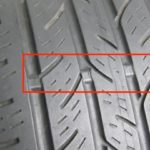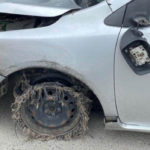Tires are made of rubber and need to have grooves and treads to increase traction when the vehicle is in motion. The treads also create enough friction for the wheels to move continuously rather than spin in inertia. Therefore, car owners should regularly check the tire wear to ensure safety while driving.

All types of tires have grooves and treads. (Illustration)
Usually, after a long period of use and exposure to the environment, these tread patterns will show signs of wear, causing the tires to lose grip on the road and causing skidding. Therefore, car owners should frequently check and replace the tires according to the manufacturer’s recommendations.
The function of treads on tires
Most current car models use tires with treads. However, racing cars are usually equipped with slick tires because in dry conditions, the smooth design of the tires increases the contact area between the tire and the road surface.
Tread patterns may be small details, but they have essential functions, such as:
Increasing friction and grip on the road surface: Ensuring continuous movement of the tires and preventing skidding caused by inertia.
Creating air holes in the tires to balance the pressure: Helping the brake system work less because the tires with treads can provide sufficient traction, thereby reducing brake wear.
Preventing skidding on wet surfaces, ensuring safety for drivers: The friction created by the tires’ movement against the road surface helps keep the vehicle moving straight ahead. Rubber tires need grooves and treads to increase traction on the moving surface, create enough friction for the wheels to move continuously, rather than just spin and skid due to inertia.
Without grooves and treads on the tires, they will not generate enough friction to keep the wheels moving forward. The phenomenon of skidding often occurs when the wheels roll at high speed on the road, caused by the centrifugal force of the wheel axle. If this happens frequently, it naturally affects the stability of the vehicle and causes it to fall over.
The design of the tire’s treads usually involves deep longitudinal grooves to ensure that the tires adhere tightly to the road and prevent skidding. However, over time, these grooves and treads on the tires will wear out, lose grip, or the grooves will no longer be deep enough, indicating the need for new tires.

Use a tire pressure gauge to ensure that the tire is not overinflated compared to the standard (Illustration).
The presence of grooves and treads on the tires also affects the quality of braking if it wears out prematurely. When the horizontal and vertical grooves are still deep enough and maintain good traction, the driver can easily control and master the speed. From there, the number of times the brakes need to be applied is reduced, minimizing brake wear.
How to check tire wear
Worn-out tires that are not replaced in a timely manner can lead to many dangerous situations when driving. Therefore, regular tire checks are necessary. Here is a guide to checking tire wear:
Check tire pressure: Under normal conditions, tire pressure decreases by about 0.068 atmospheres per month. If the vehicle frequently operates under complex terrain or high temperatures, the decrease will be greater. Improper pressure (underinflated or overinflated) will cause tires to wear out faster, compromising safety while driving. Steps to check the pressure using a pressure gauge:
Step 1: Remove the valve cap, then place the pressure gauge on the valve stem.
Step 2: Apply strong force to make the squeaking sound disappear.
Step 3: Remove the pressure gauge and read the pressure.
Step 4: Compare the obtained values with the standard pressure to accurately assess the tire’s condition and proceed with deflation or inflation if necessary.
Use a tire pressure gauge to ensure that the tire is not overinflated compared to the standard.
In addition, vehicle users should properly care for and maintain the tires to increase their lifespan.
Check the condition and age of the tires: Keeping track of the condition and lifespan of the tires is also very important. The lifespan of the tires depends on usage conditions, maintenance, and factors such as temperature. Drivers should regularly observe the tire surface, sidewalls to detect any cuts, scratches, punctures, bulges, or impacts… and replace them promptly. Users should also choose the appropriate car tires to avoid unexpected incidents during use.
Check the wear of tire treads: New tires that have not been used will have protruding treads and no signs of wear. On the contrary, for tires that have been in use for some time, these details will begin to crack, break, and even disappear from the surface. Therefore, car owners should regularly check and replace tires when the tread wear reaches about 1.6mm to ensure safety during operation.
According to VTC.vn
































